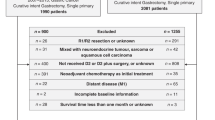Abstract
To evaluate the rationality of the current nodal staging system in gastric cancer, we retrospectively analyzed 152 patients with perigastric node involvement localized to a single station, in whom the route of metastasis to distant nodes was limited. No significant differences in pathology or survival were observed between patients with stage n1 and those with stage n2–3 nodal involvement, but the mean (standard deviation) number of perigastric nodes dissected was 22.6 (12.6) in those with stage n1 involvement and 18.5 (9.5) in those with stage n2-3 involvement (P=0.04). When perigastric node involvement was localized to station 3, the mean number of dissected station 3 nodes was 7.7 (4.2) in n1 patients and 5.3 (2.8) in n2-3 patients (P=0.04). This tendency was also observed in patients with perigastric node involvement limited to either station 1 (P=0.08) or station 6 (P=0.11). Thus, patients with fewer perigastric nodes may have more lymphatics that bypass perigastric nodes and empty directly into distant nodes, increasing the likelihood of skip metastases. The number of positive nodes, affected to a lesser degree by lymphatic distribution than the location of positive nodes, should be incorporated into the staging criteria.
Similar content being viewed by others
References
Japanese Research Society for Gastric Cancer (1995) Japanese classification of gastric carcinoma. First English edn. Kanehara, Tokyo
Hermanek P, Sobin LH (eds) (1987) TNM classification of malignant tumors (edn. 4). Springer, Berlin
Ichikura T, Tomimatsu S, Okusa Y, Uefuji K, Tamakuma S (1993) Comparison of the prognostic significance between the number of metastatic lymph nodes and nodal stage based on their location in patients with gastric cancer. J Clin Oncol 11:1894–1900
Borchard F, Betz P (1991) Number and size of perigastric lymph nodes in human adults without gastric cancer. Surg Radiol Anat 13:117–121
Wagner PK, Ramaswamy A, Rüschoff J, Schmitz-Moormann P, Rothmund M (1991) Lymph node counts in the upper abdomen: anatomical basis for lymphadenectomy in gastric cancer. Br J Surg 78:825–827
Haagensen CD (1972) General anatomy of the lymphatic system. In: Haagensen CD, Feind CR, Herter FR, Slanetz CA Jr, Weinberg JA (eds) The lymphatics in cancer. Saunders, Philadelphia, pp 22–41
Schmitz-Moormann P, Thomas C, Pohl C, Söhl R (1982) Pathoanatomical demonstration of lymph node metastases in a surgical specimen. Pathol Res Pract 174:403–411
Cawthorn SJ, Gibbs NM, Marks CG (1986) Clearance technique for the detection of lymph nodes in colorectal cancer. Br J Surg 73:58–60
Scott KWM, Grace RH (1989) Detection of lymph node metastases in colorectal carcinoma before and after fat clearance. Br J Surg 76:1165–1167
Sawai S, Takahashi S, Kato G, Takenaka A, Tokuda H, Hagiwara A, Takahashi T (1985) Endoscopic injection of activated carbon particle (CH44) for extended radical lymphadenectomy of gastric cancer (in Japanese). Nippon Shokaki Geka Gakkai Zasshi (Jpn J Gastroenterol Surg) 18:912–917
Umeno T, Tanaka S, Tomita A, Mitsuishi K, Ohtsuka K, Ikeda S, Fukamura T (1995) Study of lymphatic flow and lymph node metastasis from No. 3 and No. 6 lymph node in gastric cancer (in Japanese with English abstract). Nippon Rinsho Geka Igakkai Zasshi (J Jpn Soc Clin Surg) 56:2031–2034
Yoshida K, Ohta K, Ohhashi I, Nakajima T, Takagi K, Nishi M (1988) Studies on gastric lymphatics by using activated carbon particles (CH44) and lymph node metastasis of gastric cancer (in Japanese with English abstract). Nippon Geka Gakkai Zasshi (J Jpn Surg Soc) 89:664–670
Nakagawa N (1992) Rationale for dissection of lymph node associated with gastric carcinoma located at the greater curvature of the stomach — the correlation between the pattern of lymph node metastasis and distribution of blackened lymph nodes by vital staining using activated carbon particles (CH40) (in Japanese with English abstract). Nippon Shokaki Geka Gakkai Zasshi (Jpn J Gastroenterol Surg) 25:2460–2469
Author information
Authors and Affiliations
Rights and permissions
About this article
Cite this article
Ichikura, T., Furuya, Y., Tomimatsu, S. et al. Relationship between nodal stage and the number of dissected perigastric nodes in gastric cancer. Surg Today 28, 879–883 (1998). https://doi.org/10.1007/s005950050246
Received:
Accepted:
Issue Date:
DOI: https://doi.org/10.1007/s005950050246




